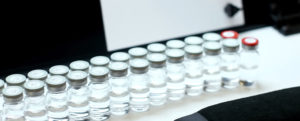
In USP <1790> it focuses on detecting and removing units of visible particles; in addition, it promotes the need of preventing particulate contamination—which only comes from identifying the particle. Most pharmaceuticals require an understanding of particulate matter contamination. The ability to identify and characterize a particle is extremely beneficial with improving products within the development process. Identifying particulate matter will help prevent product recalls, unwanted particles and allows production of better quality products.
The first step is to isolate and remove visible particles from the product. Raman and LIBS analyses are most commonly used to complete the identification process of a particle. Typically, these tests involve lasers with specific spectral ranges and Infrared Microscope.
In this article, published by Drug Development & Delivery, there are examples of how to identify common particles. For example, in a microscopic image of a typical fiber particle, the particle would appear smooth and not twisted. When viewing a microscopic image of glass with sodium (from a syringe), the particle would appear with many flakes. When products have consistent particles from the similar vile type and closures, manufactures will not always have an entire identification process. Most identifiers will know what type of particle comes from a syringe needle or rubber stopper, etc.
The available use of different filter systems makes separating the particles from a product a lot easier to manage; granting the identification process faster and convenient. Tracking the amount of vials and syringes that have particles and tracking the size of particles will determine the status of the process. Constantly checking and cleaning equipment will also help reduce the amount of particles and lead to a better system.
InQuest Science’s Identifier System will help keep track of particle defects, reducing recalls and helping manufactures prevent falsification of particles in parenterals. The Identifier System supports USP<790> and USP<1790>. Read the full article for more information on the importance of identifying particles.

